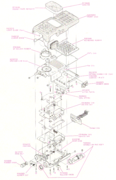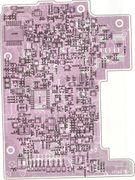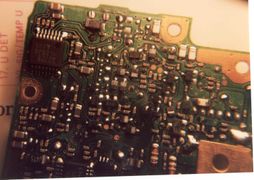Yaesu FT-51
Jump to navigation
Jump to search
Back around 1999 I got the the FT-51R transceiver which was top of the line from Yeasu at the time.
The FT-51nd was the Japanese version of the radio and supported receive using a ÷2 prescaler on 800 MHz. These parts were removed from the FT-51R transceiver for compliance with the Telephone Disclosure and Dispute Resolution Act prohibition on scanners that can receive AMPS frequencies.
I came up with the modification below, and performance was basically crappy IMO.
Full Modification
Here is the mod to restore your HT to full coverage.
The first we "trick" the CPU to think it is in a test mode on each band. Then
the 440 mother board must be modified to switch the incoming rf into a divide
by 2 prescaler. the out put of this is then fed into the 440 receiver like a
normal 350-500 MHz signal.
Here we go with the first part of the mod.
Going through with this will cause the CPU to be reset and clear all the memory
information. Make a back up of the radio first if you don't want to loose any
thing.
1. Open up the radio (refer to fig 1)
a. Remove the Knob and the lock nut from around the shaft. I find a
small screw driver to work well for this. If you have a spanner
wrench use it!
b. Remove the screw from in between the MIC and speaker jacks.
c. Remove the 4 screws from the back metal panel, and the 4 screws
from the plastic L cover over the back of the key pad.
d. Remove the battery release tab from the back, and the 2 screws
securing the L cover to the metal back cover.
e. Remove the front cover, being careful not to loose the gasket.
f. Release the flat ribbon cable from the Main Unit. Then angle the
Main unit upwards and pull it away from the radio.
2. Change the solder jumpers on the radio. (refer to fig 2)
a. There are 7 jumpers next to the the sub CPU, Q1001 arranged in the
below fashion:
() JP1001
() JP1002
() JP1003
() JP1004
() JP1005
() JP1006
() JP1007
b. If you open solder pad JP1006 you will have extended transmit,
JP1007 will allow you to change the Band and IF selection in the
internal alignment menu. (more on this in the next part of the mod.)
JP1004, if closed, will give you a tone burst in place of the monitor
switch, and vice versa.
c. To make this mod work, you must open JP1006, and JP1007.
3. Once the jumpers are configured, reassemble the radio temporarily.
a. Insert the MAIN Board into the aluminum panel and attach the ribbon
cable to the main unit.
b. Replace the front cover and L cover, and secure with a few screws.
4. The radio must be put into a "Internal System Alignment Routine".
a. Attach the battery to the radio.
b. Turn the radio on whilst holding the 2 volume and squelch buttons
and the call buttons.
5. This will provide access to alignment menu which will allow you to adjust
these settings for each band. To select the setting you want to adjust
use the dial. To adjust the setting press the FM key until "F" blinks.
Once you are done adjusting the setting tap the FM key. This will save
the setting. once you are done with every thing, you must make all
changes permanent. To do this press the CALL key. The radio will power
off.
a. Band and IF
b. S-meter
c. Deviation (low and High)
d. Squelch
I will describe each of these settings in appendix A.
6. All we need to do is adjust the Band edge setting for each band. The
setting for each band is "BAND 7". I have a partial list of the
different band layouts listed in appendix B.
a. First press the FM key and use the up and down keys to get the
display to read "BAND 7" on the VHF Side, press FM to save the
setting.
b. Press the band key to get to the other band
c. Press the FM key and use the up and down keys to get the
display to read "BAND 7" on the UHF Side, press FM to save the
setting.
d. Push the Call key to save all settings. The radio will turn off.
7. Turn the radio on. It should now tune from 60-999 MHz on each Band.
8. If all you wanted was the expanded receive with out 700-999 MHz, you are
done! If not, it time for the hard part.
Modifying the 440 board
In this section you will be installing some switching transistors on the 440
Mother Board. This involves very small SMD parts. If you are not careful you
can mess-up your radio!
1. you will need the fowling parts from Yaesu:
PART TYPE YAESU P/N
C3082 -- 2 pF -------------- K22148206
C3089 -- 2 pF -------------- K22148206
C3090 -- 2 pF -------------- K22148206
c3091 -- 2 pF -------------- K22148206
C3108 -- .001 µF ----------- K22148820
L3021 -- .022 µH ----------- L1690381
L3030 -- .0068 µH ---------- L1690378
Q3031 -- 2SC4227-R32 ------- G3342277B
Q3032 -- 2SC4228-R42 ------- G3342287B
Q3038 -- 2SC4228-R42 ------- G3342287B
Q3039 -- 2SC4228-R42 ------- G3342287B
R3054 -- 33K --------------- J24189155
R3055 -- 33k --------------- J24189155
R3060 -- 1k ---------------- J24189119
R3066 -- 470 --------------- J24189111
R3071 -- 470 --------------- J24189111
2. Expose the 440 MHz board. (again refer to fig 1)
a. Remove the Knob and the lock nut from around the shaft. I find a
small screw driver to work well for this. If you have a spanner
wrench use it!
b. Remove the screw from in between the MIC and speaker jacks.
c. Remove the 4 screws from the back metal panel, and the 4 screws
from the plastic L cover over the back of the key pad.
d. Remove the battery release tab from the back, and the 2 screws
securing the L cover to the metal back cover.
e. Remove the front cover, being careful not to loose the gasket.
f. Release the flat ribbon cable from the Main Unit. Then angle the
Main unit upwards and pull it away from the radio.
g. Remove the contact unit (the small board that the ribbon cable
goes into, that is plugged into the 144 and 440 units.) by
alternately prying gently up on each corner of it with a small flat
screw driver.
h. Remove the 4 screws in shield over the 144 unit, and the 1 screw
that goes into the the board it self.
i. Lift the top shield, the 144 board, and the second shield over the
440 board.
j. Remove the screw from the antenna connector, and lift the 440 unit
out of the radio.
2. Install these parts according to the parts layout diagram (fig 3 also fig
4 shows the board from my radio)
3. Reassemble the radio.
4. Power the radio on, you should be able to receive 700-999 MHz now.
Notes on the performance of the mod:
I have done this to my radio, S/N 5H132340, and it has worked just fine. The
sensitivity in not great, but it works well enough to receive my local police
department on 856.2125. The step size is fixed to 12.5 kHz, but you can enter
any frequency you like on the keypad, and it will work. The shitty software
from R/T Sys will not allow you to program or edit any memory that has
700-999 programed into it!
Here is the sensitivity of my radio for a 12 dB SINAD ratio.
FREQ. µV dBm
600 none none
650 none none
700 133 -64.5
750 77.4 -69.2
800 31.8 -76.9
850 9.8 -87.1
900 9.3 -87.7
950 25.1 -79.0
999 30.3 -77.4
Appendix A
INTERNAL SYSTEM ALIGNMENT
These adjustments are all done in software, if you want to change the
deviation, or the response of the S-meter you can easily do it from the keypad.
The setting of each adjustment is separate for each band.
1. Deviation adjustment.
The radio will allow you to adjust the high and low gain separately,
which allows you to "customize" the transmit audio for you own voice.
The adjustment for the high frequency's is "MOD H" and the setting for
low frequency's is "MOD L". These can be adjusted with the up and down
keys. The factory says to adjust the radio to 4.2-4.5 kHz with a 25mV
1 kHz tone fed into it.
2. S-Meter
The adjustments that can be made here require the radio be receiving a
signal to set the adjustment, as it can not be adjusted with the up
and down keys, like the deviation can be.
The "S-FULL" adjustment sets the amount of signal that would cause the
S-Meter to light fully. The factory says the amount of signal to
inject to the receiver, is +20dBµ with 1 kHz tone and 3.5 kHz deviation.
The "S-1" adjustment sets the amount of signal that would cause the
very first unit to light on the S-meter. The factory says the amount
of signal to inject to the receiver, is -5dBµ with 1 kHz tone and 3.5
kHz deviation.
3. Squelch
This setting adjusts the action of the squelch. (this is my
understanding) The Squelch circuit is a Bi-level acting squelch,
meaning that as long as a strong signal is being received the squelch
will chop off immediately after losing a Carrier. When the signal is
weak, there is some hysteresis introduced into the circuit to prevent
it from chopping a weak signal.
The first adjustment, "SQL TH" will set the Threshold for a weak
signal. The factory setting is a -11dBµ signal. You can mess with
this if you want to, but it is best to leave it alone. if you do
write down your present settings first.
The second adjustment, "SQL TI" sets the signal level required to
cause the squelch to close at the end of a signal with out leaving a
burst of static (i.e. a squelch tail). This is set at -5dBµ from the
factory. This can also cause a signal that is very wide (5-6 kHz of
deviation) to clip. If this happens to you, but the signal sounds fine
when listing to it with the squelch open, this needs to be set to a
larger signal level. I have had to do this to my radio, as quite a
few hams have rich audio!
4. IF selection
I have no idea what this does other than setting the receive frequency
different from the displayed freq.
I have experimented with this setting on VHF and found the following
off sets for the actual RX frequency vs. the displayed frequency.
IF # Offset (All in MHz)
1 +29.8
2 +27.8
3 +23.25
If you have any info on this at all please write me an email and let
me know.
Appendix B
Band setting
I have Experimented with the BAND setting and have found the following limits
on VHF for the various settings of it.
Band # RX Range TX Range
0 60-180, 300-512 144-148
2 110-180 140-174
3 110-180 140-174
4 110-180 144-146
5 144-146 144-146
6 110-180 144-148
7 60-999 60-999
UHF
0 300-512, 700-999, 60-180 440-443
If you have any corrections/additions to this please email me with them.
Appendix C
Settings of my radio (S/N 5H132340) from the factory.
Setting VHF UHF
Band 1 1
IF # 0 0
S-FULL BB 66
S-1 47 23
SQL TH 72 84
SQL TI 45 5D
MOD L 25 20
MOD H 27 24
Appendix D
Avaliable tuning steps for various band segments.
This part was submitted by Kent, KB1ESG.
Side Rx range (MHz) Available Steps (KHz)
___________________________________________
VHF 60 - 179.95 5, 10, 12.5, 15, 20, 25, 50
180 - 999 10, 12.5, 20, 25, 50
UHF 60 - 699.995 5, 10, 12.5, 15, 20, 25, 50
700 - 999 12.5
This is version 2.1 of this document and may be posted by any one, to any
place in cyberspace. You may not charge for access to any place
it is posted. It may not be published in any book with out my express written
consent. You may modify as long as credit is given to Me (KB9MCI), Yaesu
Japan, Marty N8XIH, Kent KB1ESG, and a copy it is emailed to me. This copyright
statement must remain in place on any copy's of this document.
Bryan Fields, KB9MCI
Figures referenced above
Docs
thumb|FT-51R Technical Supplement Service Manual - A scan of the FT-51R Service Manual



